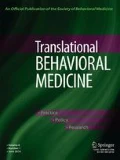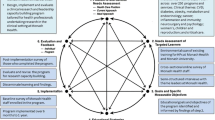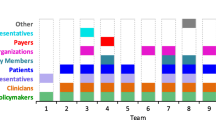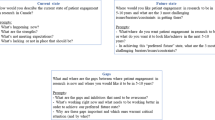Abstract
For research to be useful, trustworthy, and ultimately lead to greater dissemination of findings to patients and communities, it is important to train and mentor academic researchers to meaningfully engage community members in patient-centered outcomes research (PCOR). Thus, it is necessary for research institutions to strengthen their underlying infrastructure to support PCOR. PATIENTS—PATient-centered Involvement in Evaluating effectiveNess of TreatmentS—at the University of Maryland, Baltimore, focuses on improving PCOR methods and addressing health disparities. It relies on evidence-based engagement methods to sustain and leverage innovative partnerships so patients, health care providers, and academic partners are motivated to participate in the conduct and dissemination of PCOR. Program components address training needs, bi-directional engagement, cultural competency, and dissemination and implementation. Activities (guided by community representatives, leadership from university schools, patient advocates, and PCOR experts) include providing resources, conducting PCOR projects, engaging community members, and disseminating PCOR findings. With its emphasis on the broad range of PCOR topics and methods, and through fostering sustainable relationships with community members and researchers, PATIENTS has successfully cultivated bi-directional partnerships and provided operational and scientific support for a new generation of skilled PCOR researchers. Early evidence of effectiveness includes progress in training and mentoring students and investigators, an increase in submission of PCOR proposals, and community-informed strategies for dissemination. Programs such as PATIENTS reinforce the value of bridging the traditional divide between academia and communities to support patient- and community-engaged dissemination and implementation research and foster sustainable PCOR infrastructure.

Similar content being viewed by others
References
Horowitz, C. R., Robinson, M., & Sarena, S. (2009). Community-based participatory research from the margin to the mainstream: are researchers prepared? Circulation, 119, 2633–2642.
Hartwig K, Calleson D, Williams M. Unit 1: Community-based participatory research: getting grounded. In: The examining community-institutional partnerships for prevention research group. Developing and sustaining community-based participatory research partnerships: a skill-building curriculum. www.cbprcurriculum.info. 2006. Accessed May 15, 2016.
Minkler, M. (2000). Using participatory action research to build health communities. Public Health Reports, 115(2–3), 191–197.
Tavernise S. Health problems take root in a west Baltimore neighborhood that is sick of neglect. The New York Times. April 29, 2015. http://www.nytimes.com/2015/04/30/us/health-problems-take-root-in-a-west-baltimore-neighborhood-that-is-sick-of-neglect.html?emc=eta1&_r=1 Accessed May 30, 2016.
McDaniels, A.K. Collateral damage: advocates aim to save Baltimore children from impact of violence. The Baltimore Sun., 2014. http://www.baltimoresun.com/health/bs-md-health-violence-121114-story.html. Accessed May 31, 2016.
Mullins, C. D., Abdulhalim, A. M., & Lavallee, D. C. (2012). Continuous patient engagement in comparative effectiveness research. Journal of the American Medical Association, 307(15), 1587–1588.
Ahmed, S. M., & Palermo, A. G. (2010). Community engagement in research: frameworks for education and peer review. American Journal of Public Health, 100(8), 1380–1387.
Carter-Edwards, L., Cook, J. L., McDonald, M. A., Weaver, S. M., Chukwuka, K., & Eder, M. M. (2013). Report on CTSA consortium use of the community engagement consulting service. Clinical and Translational Science, 6(1), 34–39.
Handley M, Pasick R, Potter M, Oliva G, Goldstein E, Nguyen T. Community engaged research: a quick-start guide for researchers. From the Series: UCSF Clinical and Translational Science Institute (CTSI) resource manuals and guides to community-engaged research, P. Fleisher, ed. Published by Clinical Translational Science Institute Community Engagement Program, University of California San Francisco. https://accelerate.ucsf.edu/files/CE/guide_for_researchers.pdf. Accessed June 7, 2016.
Kauffman, K., dosReis, S., Ross, M., Barnet, B., Onukwugha, E., & Mullins, C. D. (2013). Engaging hard-to-reach patients in patient-centered outcomes research. Journal of Comparative Effectiveness Research., 2(3), 313–324.
Faridi, Z., Grunbaum, J. A., Gray, B. S., Franks, A., & Simoes, E. (2007). Community-based participatory research: necessary next steps. Preventing Chronic Disease, 4(3), A70.
Fadem, P., Minkler, M., Perry, M., Blum, K., Moore, I., & Rogers, J. (2003). Ethical challenges in community based participatory research. In M. Minkler & N. Wallerstein (Eds.), Community based participatory research for health (pp. 242–262). San Francisco: Jossey-Bass.
Lavallee, D. C., Wicks, P., Alfonso, C. R., & Mullins, C. D. (2014). Stakeholder engagement in patient-centered outcomes research: high-touch or high-tech? Expert Review of Pharmacoeconomics & Outcomes Research., 14(3), 335–344.
Sofolahan-Oladeinde, Y., Mullins, C. D., & Baquet, C. R. (2015). Using community-based participatory research in patient-centered outcomes research to address health disparities in under-represented communities. Journal of Comparative Effectiveness Research., 4(5), 515–523.
Mullins, C. D., Vandigo, J., Zheng, Z., & Wicks, P. (2014). Patient-centeredness in the design of clinical trials. Value in Health., 17(4), 471–475.
Mullins CD, Chiauzzi E, Frye D, Mack M. Continuous patient engagement: how do we partner with patients throughout the research life cycle? Issues Panel, ISPOR 20 th International Annual Meeting. Philadelphia. 2015.
Chauhan, C. (2016). Patients’ views can improve clinical trials for participants. BMJ, 353.
Acknowledgments
Westat serves on the PATIENTS internal steering committee and as the internal evaluators of the program. The authors gratefully acknowledge Liz Jansky for her feedback and Nora Dluzak for manuscript preparation. They would also like to thank the community partners and trainees who participated in the interviews as well as the staff and partners of the PATIENTS program.
Author information
Authors and Affiliations
Corresponding author
Ethics declarations
Reported findings and data
The findings reported have not been previously published and the manuscript is not being simultaneously submitted elsewhere. These data have not been reported elsewhere. Authors have full control of all primary data and agree to allow the journal to review these data if requested.
Funding
This study was funded by AHRQ Grant Number: R24 HS022135.
Conflict of interest
All authors declare that they have no conflict of interest.
Ethical approval
All procedures performed in studies involving human participants were in accordance with the ethical standards of the institutional and/or national research committee and with the 1964 Helsinki declaration and its later amendments or comparable ethical standards.
Informed consent
Informed consent was obtained from all individual participants included in the study.
IRB
The described study has received IRB approval from University of Maryland, Baltimore and Westat.
Additional information
Implications
Policy: Investment and support from funders and policymakers can strengthen institutional infrastructure to train and mentor researchers in patient-centered outcomes research (PCOR).
Practice: Healthcare delivery systems are critical partners for dissemination and implementation of findings emerging from research that engages patients and communities.
Research: For research to be useful, trustworthy, and lead to greater dissemination of findings, academic researchers must partner with patients and communities in PCOR.
About this article
Cite this article
Huang, J., Lipman, P.D. & Daniel Mullins, C. Bridging the divide: building infrastructure to support community-academic partnerships and improve capacity to conduct patient-centered outcomes research. Behav. Med. Pract. Policy Res. 7, 773–782 (2017). https://doi.org/10.1007/s13142-017-0487-z
Published:
Issue Date:
DOI: https://doi.org/10.1007/s13142-017-0487-z




